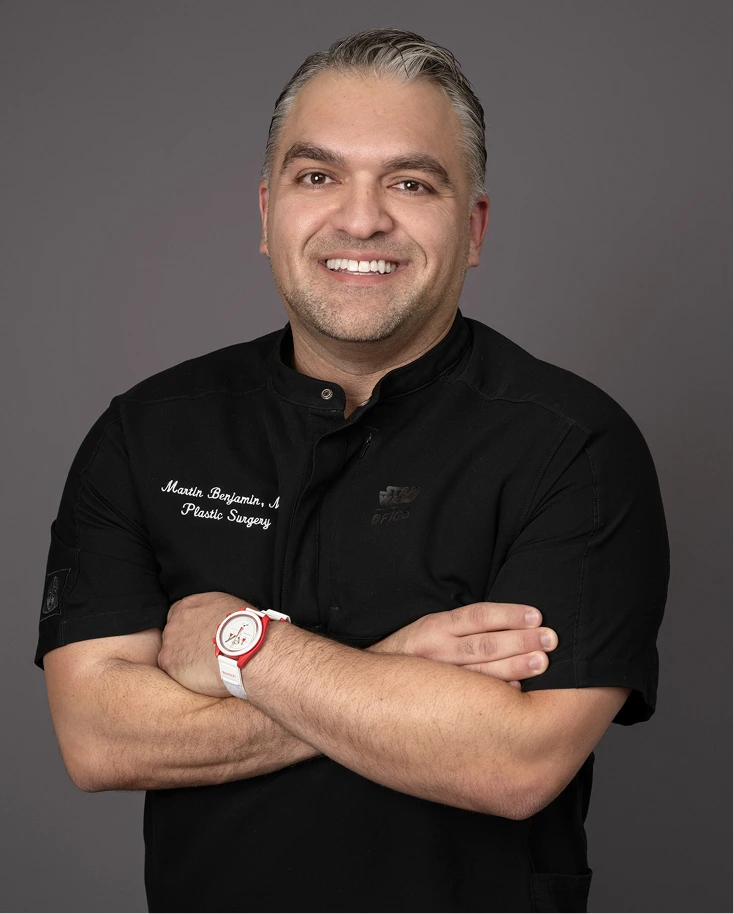If you are looking for an efficient solution to male breast enlargement, Dr. Martin Benjamin offers a refined approach called one-suture gynecomastia. This minimally invasive technique addresses excess glandular and fatty tissue through one small incision, helping men achieve a more masculine chest with less downtime. Our Scottsdale practice combines surgical precision with advanced technology to deliver natural-looking results that align with your goals.

One-suture gynecomastia is a specialized surgical technique that treats male breast enlargement by addressing both glandular tissue and excess fatty tissue. Gynecomastia often results from imbalances in hormone levels, leading to the development of a more feminine chest contour. Our procedure typically involves a minimally invasive approach that targets cosmetic problems with one tiny incision in the nipple area. On average, the treatment takes about 45 minutes. It is commonly chosen by patients seeking a discreet and efficient solution to restore a flatter, more masculine chest appearance.
Preparation for gynecomastia surgery begins with a physical examination to assess the extent of tissue involved and determine the best surgical approach. During this evaluation, Dr. Benjamin will identify the presence of excess fat and glandular tissue contributing to the appearance of male breasts. You may be advised to avoid certain medications, stop smoking, and maintain a stable weight in the weeks leading up to the procedure to support a smooth recovery and optimal results.
The one-suture gynecomastia procedure is typically performed under IV sedation or general anesthesia to ensure patient comfort and safety throughout the surgery. This allows Dr. Benjamin to work precisely and efficiently while minimizing discomfort or movement.
A key feature of our technique is the use of a single tiny incision strategically placed in the nipple area for the gland removal. This discreet incision placement provides direct access to the underlying glandular tissue while minimizing visible scarring. The small size and location of the incision make the approach minimally invasive compared to traditional methods. One other small incision is made in each armpit for the chest liposuction.

Candidacy for this procedure is typically determined during a consultation that includes a physical evaluation, medical history review, and an assessment of goals. One-suture gynecomastia may be considered for generally healthy men experiencing enlarged male breasts due to excess tissue in the chest area.
Candidates often fall into the following groups:
The cost of one-suture gynecomastia in Scottsdale ranges from $7,500 to $10,500. Pricing can vary based on the complexity of the case, the extent of excessive breast tissue, and whether additional sculpting of the entire chest is needed. Our technique may also reduce associated facility and recovery costs. A detailed price quote will be provided after a physical examination and consultation.

In some cases, male breast enlargement may resolve without intervention, particularly in adolescent males experiencing temporary hormonal imbalances. This condition, known as adolescent gynecomastia, often improves as hormone levels stabilize. However, persistent male breast enlargement caused by excess glandular tissue or related medical conditions—such as hormonal disorders or prostate cancer treatments—typically requires medical evaluation and may not resolve on its own.
Non-surgical options may help reduce the appearance of excess breast tissue in select cases, particularly when caused by weight gain or hormonal fluctuations. However, to fully address gynecomastia, especially when excess glandular tissue is involved, surgical intervention is often necessary. While non-invasive methods can improve the upper body through fat reduction, the treatment experience tends to be less definitive without surgery.
Choosing to correct gynecomastia early can prevent long-term self-consciousness and emotional discomfort. Although the condition is typically well-hidden under clothing, delaying treatment can lead to greater tissue buildup or skin laxity over time, making future correction more complex.
Yes, certain medications can interfere with the treatment process and should be avoided before and after surgery. These may include blood thinners, anti-inflammatory drugs, and some herbal supplements. A complete list is reviewed during the consultation to ensure safety and optimal healing.
In moderate gynecomastia, the skin often retracts well on its own, especially when fatty tissue is the primary concern. However, in more severe cases where skin laxity is significant, additional skin tightening treatments may be considered to enhance the final result and improve chest definition.
Selecting a board-certified specialist ensures a higher standard of training, safety, and surgical precision. Our experienced surgeon, Dr. Benjamin, brings extensive knowledge and refined technique to procedures designed to restore a natural, masculine form. Certification also reflects a commitment to ethical care and ongoing education in the latest surgical advancements.